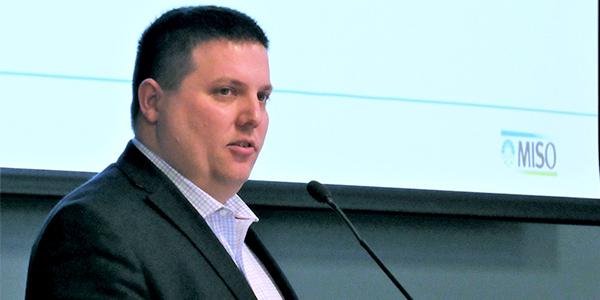By Amanda Durish Cook
MISO last week proposed bringing the three major players in its load forecasting together to coordinate on predictions for long-term transmission planning in the footprint.
MISO’s proposal would have both Purdue University’s State Utility Forecasting Group (SUFG) and consulting firm Applied Energy Group working with 20-year forecasts provided by load-serving entities. The RTO uses Applied Energy for distributed resource data predictions in its annual Transmission Expansion Plan.
The idea came in part from the Coalition of Utilities with an Obligation to Serve in MISO (CUOS), an ad hoc group of utilities and regulators, which proposed to require LSEs develop a 20-year base load forecast that includes monthly predictions for energy and non-coincident peaks. (See MISO Utilities Float New Load Forecasting Approach.)
The RTO put a temporary hold on ordering more independent load forecasts from the SUFG while it explored other stakeholder-proposed forecasting options. (See MISO Looks to Members for Load Forecasting Ideas.) It had received stakeholder criticism for its plan to order four versions of the Purdue forecast, each tailored to one of the futures used to inform its annual transmission plan, beginning with MTEP 20.
Speaking during an Oct. 12 special conference call, MISO planning manager Tony Hunziker said the RTO’s new approach draws from the CUOS proposal in incorporating the LSEs’ 20-year forecasts.
MISO would send LSE-originated demand and energy forecasts to the SUFG, which would compile and analyze them to inform its state-by-state forecast. The RTO also envisions the SUFG using LSE data to produce a complete 20-year demand and energy forecast for each of the 140-plus LSEs, which will influence the four MTEP futures. The SUFG uses its state-by-state forecast to corroborate what share of a state’s load is located within MISO territory.
The LSEs’ gross forecasts would not include energy efficiency or other demand-side factors, such as distributed resources and electric vehicle programs. MISO staff said the RTO will ask LSEs to submit demand-side data separately to AEG, which would use them to develop the demand-side management potentials in the futures.
But some stakeholders are unconvinced that LSEs can simply change their forecast methods in under two years to detach energy efficiency totals from their forecasts.
Hunziker said LSEs, MISO staff and the SUFG will be able to communicate throughout the forecasting process.
“As [the SUFG] is looking at the data and they see an irregularity, there’s a feedback loop. They can get ahold of the LSE that made the forecast and discuss and hash [it] out,” Hunziker said.
Stakeholders were also concerned about how the SUFG would adjust LSEs’ original forecasts to make the final LSE-specific forecasts used in the MTEP.
Hunziker said the SUFG will use its independent load data to fill in any missing gaps.
“There may be entities that don’t provide some information, and we want to fill in those gaps. That’s always been a concern for MISO,” Executive Director of System Planning Aubrey Johnson said. “We still need to fill in for LSEs that don’t provide forecasts or submit incomplete data.”
He promised stakeholders that LSE data would be the “foundational piece” of the load forecast and said MISO will provide more detail on how and under what conditions the SUFG will modify LSE forecasts.
Johnson said MISO will present a firmed-up proposal at the Nov. 14 Planning Advisory Committee meeting. He asked for stakeholders to send written input on the proposal by Oct. 31.





